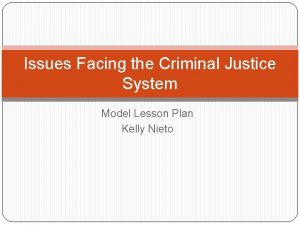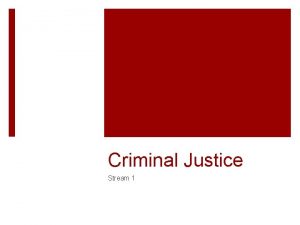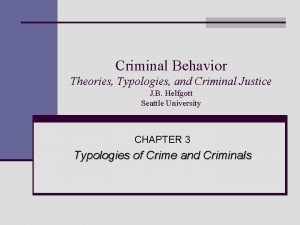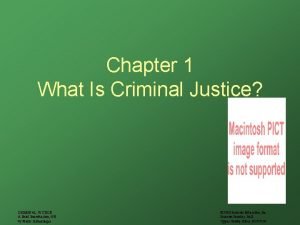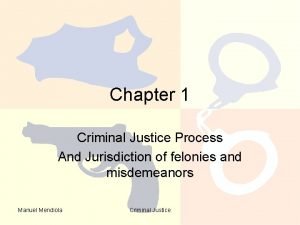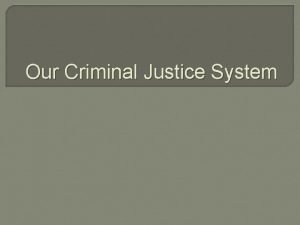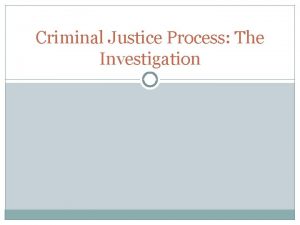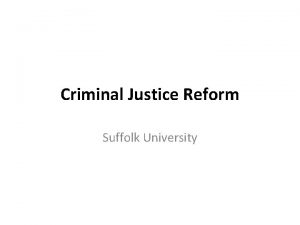FINNISH CRIMINAL POLICY AND CRIMINAL JUSTICE FROM A

















- Slides: 17

FINNISH CRIMINAL POLICY AND CRIMINAL JUSTICE FROM A NORDIC AND EUROPEAN PERSPECTIVE 15 Years of Legal Reforms in Estonia, Tartu, 19 -20 October 2006 Professor Raimo Lahti, University of Helsinki

1. Finnish and Nordic legal thinking and criminal policy n A total reform of the Finnish Penal Code (1889) by 2003 n Finland other Nordic countries have long common traditions, many-sided forms of cooperation and in many areas harmonized legislation n Finland other Nordic countries belong to the civil (statutory) law tradition, but there special features n The approaches in legislative reforms less strict in the ’system-building’ and more pragmatically oriented (e. g. , Straftatlehre) n Finland other Nordic countries represent welfare state ideology; rational and humane criminal policy n Decrease of Nordic cooperation n Emergence of similar cooperation within EU

2. Tendencies of the Finnish criminal policy since the 1960 s n (i) criticism of the so-called treatment ideology (the 1960 s) n (ii) emphasis on cost-benefit thinking (beginning of the 1970 s) n (iii) so-called neo-classisim in criminal law (the end of the 1970 s and the beginning of the 1980 s) n (iv) pragmatic reform work for a new Criminal Code by utilizing modified ideas of the above-mentioned tendencies (since the 1980 s until the beginning of the 2000 s) n (v) influence of the human and basic rights thinking on criminal law and procedural law (since the 1990 s) n (vi) challenges of the internationalization and Europeanization of criminal law (since the 1990 s)

2. Tendencies of the Finnish criminal policy (cont. ) n Towards a more rational criminal justice system, i. e. for efficient, just and humane criminal justice n The penal system should be both rational as to its goals (utility, prevention) and rational as to its values (justice, humaneness) n This kind of penal thinking had clear effects on the reasoning about the punitive level of the penal system, the types and contents of the criminal sanctions and sentencing n Since the mid-1970 s the relative number of offenders sentenced to unconditional imprisonment was on the decrease for c. 25 years, until 1999

2. Tendencies of the Finnish criminal policy (cont. ) n The average size of the prison population decreased from over 100 per 100, 000 population to 65 – to the level of the other Nordic countries n In 2000 -2005 the size increased, to average 90 per 100, 000 population; the main individual factor explaining the increase is the more punitive sanctioning against violent crime n The reassessment of the harmfulness and blameworthiness of the acts to be criminalized included, i. a. , that property crimes should be regarded as less serious than violent crimes: ‘modern crimes’ (such as economic and business offences) should be regulated in the Criminal Code and their seriousness should be comparable to that of the property crimes

3. Policies and principles of criminalization n As part of the total reform an attempt was made to assess in a uniform and systematic way the goals, interests and values that the Criminal Code should promote and protect n Deliberations during the total reform of criminal law: n (i) how should the criminalization principles be reflected in the shape and form of criminal legislation n (ii) how should we assess the seriousness of a crime and, accordingly, differentiate the offences into various chapters of the Criminal Code and into subcategories in each chapter n (iii) what part should be given to the criminalization of dangerous behaviour (Gefährdungsdelikte) n (iv) how could be ensured that criminal legislation takes into consideration the interests of different social groups

3. Policies and principles of criminalization (cont. ) n (v) how should we solve the emerging problems concerning the legal protection of new interests and values in economic and business life, environment, in human and drug trafficking and in biomedical technology n (vi) how should we nationally implement criminalizations based on international obligations n Tension between developing criminal law in the spirit of social justice, dynamic social needs and international solidarity and taking into account the constitutional and moral limitations in the use of criminal law n Diversification of criminal law (e. g. , the emergence of European economic criminal law and international criminal law); pluralism of criminal law

4. Changes in the system of criminal sanctions n Modification of the neoclassical criminal law by introducing community service, mediation, juvenile punishment n Reforms of the sanctioning system n New provisions on the waiving of penal measures in 1990 n Community service, experimental in 1990, as a regular sanction in 1996 n Mediation, experiment in 1983, unified law on mediation (conciliation) in criminal and civil cases in 2005 n Provisions n Juvenile on the concurrence of offences in 1993 punishment, experimental in 1996, as a regular sanction in 2004 n New provisions on sentencing in 2003

5. Basic principles concerning the shape and form of criminal legislation n Legality principle (nullum crimen sine lege, nulla poena sine lege poenali) n As to the reform of criminal legislation, esp. the requirement of certainty of criminal law n Accommodation between the principles of comprehensibility and certainty n Limitation of the judicial discretion as for the categorization of offences and penal scales n The principle of culpability n Intention as the main form of fault; criminal liability for negligent behaviour depends on explicit specification n The culpability principle did not exclude the adoption of corporate criminal liability

6. Crime-seriousness and the differentiation of the offences n The systematic assessment of crime-seriousness and the classification of crimes have been crucial questions; understandable, because the aim of denunciation and the value of justice have been important in the reform work n E. g. , all offences with a punishment latitude containing imprisonment were intended to be defined in the Criminal Code n Cf. that the crime concept is wide and no clear and uniform system of administrative penal law has not been created

7. General conditions of criminal liability n Finnish provisions follow continental, esp. German tradition with its general system for analyzing criminal acts n Positive requirements for criminal liability include: (i) definitional elements (Tatbestandsmässigkeit); (ii) the act must be wrongful (Rechtswidrigkeit); (iii) culpability (Schuld) n Distinction n Dispute between justification and excuse about intention (dolus); as a result the provision on Intent (PC 3: 6) defines the intent in relation to the consequences (Erfolg) only whereas the intent in relation to the circumstances (Tatumstände) should be determined by relying the mistake provision in PC 4: 1 (Tatbestandsirrtum)

8. Human rights and constitutional rights in Finnish criminal law and procedure n Finland joined the European Convention on Human Rights (ECHR) in 1990 n “Human-rights-friendly” application of laws n New provisions on the fundamental rights in 1995 and a new Constitution in 1999 n “Basic-rights-friendly” application of laws

9. Finnish criminal law reform and constitutional and human rights n Ideological change with greater emphasis on constitutional and human rights in legislation, in applications of law and in jurisprudence n Strengthening of the legality principle n Esp. : nullum crimen sine lege scripta, lege praevia and lege certa n The use of the so-called blanket (reference) provision technique should be reduced and specified n Constitutional and human rights limiting the use of criminal law; accordingly, there must be a considerable social need and also from the basic rights point of view acceptable reasons for a criminalization that it restricts fundamental freedoms in an acceptable and proportionate way

10. Finnish criminal procedural law and constitutional rights n Main reforms areas: n Provisions on the pre-trial investigation and coercive measures in criminal proceedings in 1989 n Restructuring the lower court system in 1993 n Reorganizing the public prosecution in 1996 n Comprehensive reform of criminal procedure in the lower courts in 1997 and appeal courts in 1998 n Reform of legal aid and public defense in 1998 n The new criminal procedure (main hearing) is a mixed system with emphasis on adversarial handling; Swedish criminal procedure as the main model n Interaction with the reforms of substantial and procedural criminal law

11. Influence of the EU membership on the Finnish criminal justice n Emerging European criminal policy n Common principles generated by the ECHR and EC/EU law n National implementation of EC norms and EU (3 rd pillar) instruments n Framework Decisions of the EU turned out to be the most efficient instrument when furthering the mutual recognition of judgments and the approximation of legislations within European legal space n Tensions between the “security” objectives and the strengthening of the legal safeguards as an “justice” objective n United in diversity?

12. Some conclusions n Nordic criticism against unification of European (EU) criminal policy n Crime prevention is not considered seriously n Criminal n The policy is not research-based or “professional” level of repression (punitiveness) is high n EU-based criminal policy does not fulfill the demand for legitimacy n How can we improve European and national criminal policies n More theoretical discussion about the pluralism in (criminal) law; theories on criminalization and punishment should take into account trans-border crime and transnational crime control

12. Some conclusions (cont. ) n More interaction between the states and inter-/supranational organs n The increased internationalization and Europeanization of criminal law should be based on widely acceptable and rational criteria n Challenge for legal scholars and practitioners to conduct comparative studies, to increase knowledge about different legal and cultural systems and to present well argued models for decision-makers at various national and international platforms n International seminars (like “XXIX Days of Estonian Jurisprudents”) further such exchange of ideas
 Guelph cjpp
Guelph cjpp What is corrections in criminal justice
What is corrections in criminal justice Unit 2 criminal law and juvenile justice
Unit 2 criminal law and juvenile justice What are the branches of criminal justice system
What are the branches of criminal justice system Sexting laws in ct
Sexting laws in ct Nonintervention perspective of criminal justice
Nonintervention perspective of criminal justice Grass eater police
Grass eater police Eighth amendment excessive bail
Eighth amendment excessive bail Consensus model criminal justice
Consensus model criminal justice Consensus model criminal justice
Consensus model criminal justice Criminal justice stream
Criminal justice stream Interpret
Interpret Criminal typology
Criminal typology Individual rights
Individual rights Consensus model criminal justice
Consensus model criminal justice Consensus model criminal justice
Consensus model criminal justice Nonintervention perspective of criminal justice
Nonintervention perspective of criminal justice What are the layers of the criminal justice wedding cake
What are the layers of the criminal justice wedding cake







